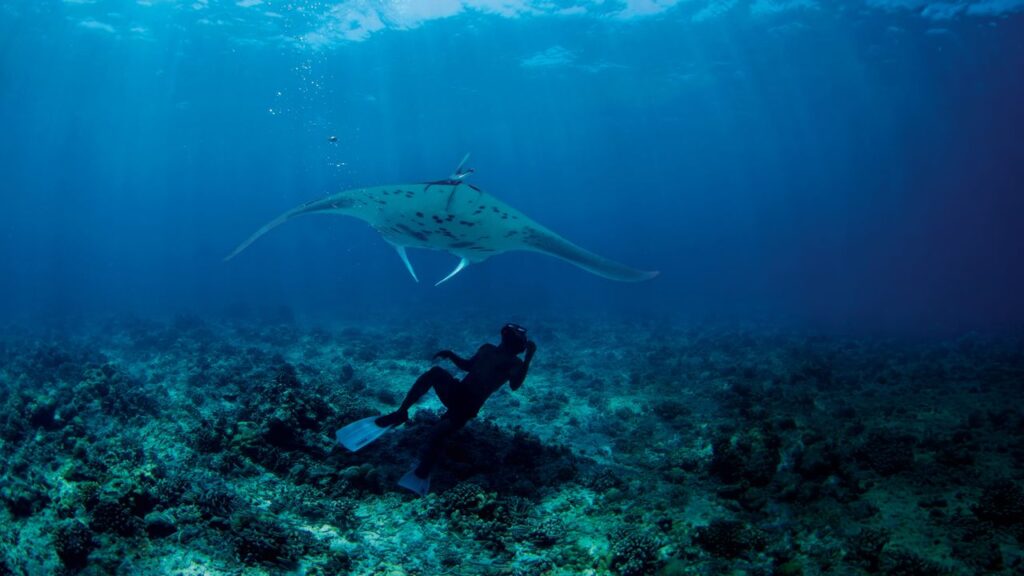Sleek, black, and diamond-shaped, they glided on nine-foot wings, mouths agape, below me. The reef manta rays had congregated in Hanifaru Bay, a shallow inlet in the Baa Atoll, and were spiraling in a cyclone formation to feed. They are one of the reasons the Maldives (#1 Island, Africa & the Indian Ocean) is such a spectacular destination for the style of tourism I love to do, which requires a wetsuit and fins. It doesn’t hurt that this nation of 1,192 islands in the Indian Ocean is also home to the seventh-largest and fifth-most-diverse coral reef on the planet.
From May to November, when the southwest monsoon blows Saharan sand into the Indian Ocean, minerals from the desert nourish microscopic phytoplankton. At night, when zooplankton rise from the ocean floor to feed on phytoplankton, lunar tides push the minuscule animals into the bay, luring hundreds of rays. In 2011, Baa Atoll became a UNESCO Biosphere Reserve, which placed its natural resources under international protection.
I was staying at Finolhu, A Seaside Collection Resort, a serene 125-villa property on one of the 75 islands that make up Baa Atoll. Ivanna Tobar, the resort’s on-staff marine biologist (many properties in the archipelago have them), gave us the lowdown as we approached the bay: “No boats are allowed inside, so we have to swim in. We get 45 minutes, then we have to come out.” Biosphere rangers would be in the water to ensure we didn’t misbehave. “No chasing, no touching, and absolutely no riding the mantas. This is a serious offense, okay?”
Very okay. I was happy the bay was so well cared for. I knew the rangers already, having spent the previous afternoon doing another of the resort’s activities with them: an ocean-plastics cleanup on Olhagiri, an islet where breeding male frigate birds puff their vermilion chests to impress females roosting in the mangroves. “If you hear those mating calls,” Tobar said, “you know there’s funny business going on.” On our outing we found no frigate birds, but we did see zillions of hermit crabs. And yet, as Tobar explained, the creatures are far outnumbered by plastics. Visitors here might never know the extent of the world’s plastics problem, because Maldives resorts assiduously clean their beaches and lagoons, but Tobar was explicit: 22 trillion pounds of plastic clutter ocean floors worldwide; 51 trillion microplastic bits choke the water. Though the Maldives enacted a ban on single-use plastics in 2022, it will take time to phase them all out, and currents bring in plastics from far-flung locales. We collected 450 pounds’ worth, which a crew from the environmental nonprofit Parley Maldives took. The organization is partnering with Adidas to turn discarded plastics into sneakers. On the ride back, I was rewarded for my hard work: Spinner dolphins performed pirouettes off the boat’s bow.
In addition to collecting plastics, altruistic guests can pitch in on coral restoration. The Maldives are of course famed for serene, palm-lined beaches, with soft white sands and crystalline waters teeming with the multihued life that relies on the reef. The marine biologists who work on these islands do their best to keep things that way, nursing baby corals to rehab reefs bleached by warming seas. Bleaching can be reversible, and some corals are more resilient. Tobar and the other biologists take polyps from surviving reefs, raise them on sandy bottoms where they’re safe from reef predators, and outplant them when they’ve matured. Guests can adopt baby corals, helping scientists tie fragments onto rebar frames and then accompanying them on snorkel dives to the lagoon to sink the frames into the water. “It’s not the usual thing that people do on vacation here,” Tobar said, “but it’s worth it.”


